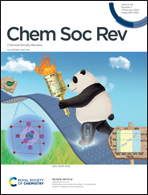Dinuclear metal complexes: multifunctional properties and applications
Abstract
The development of metal complexes for optoelectronic applications is a fertile area of research. In contrast to the rigorous development of mononuclear metal complexes, dinuclear species have been less well studied and their fundamental chemistry and applications are under-explored. However, dinuclear species present special properties and functions compared with mononuclear species as a consequence of tuning the bridging ligands, the cyclometalated ligands or the two metal centers. More recently, dinuclear species have enabled important breakthroughs in the fields of OLEDs, photocatalytic water splitting and CO2 reduction, DSPEC, chemosensors, biosensors, PDT, smart materials and so on. Here we present an overview of recent developments of dinuclear metal complexes, their multifunctional properties and their various applications. The relationship between structure and property of dinuclear species and important factors which influence device performance are discussed. Finally, we illustrate some challenges and opportunities for future research into dinuclear metal complexes. This review aims to provide an up-to-date summary and outlook of functional dinuclear metal complexes and to stimulate more researchers to contribute to this exciting interdisciplinary field.



 Please wait while we load your content...
Please wait while we load your content...